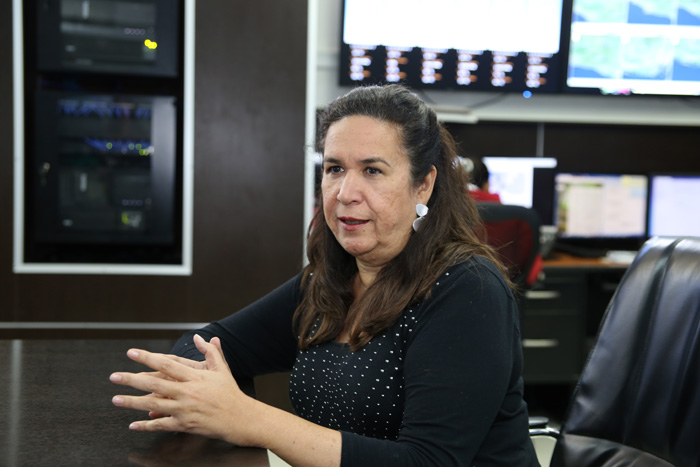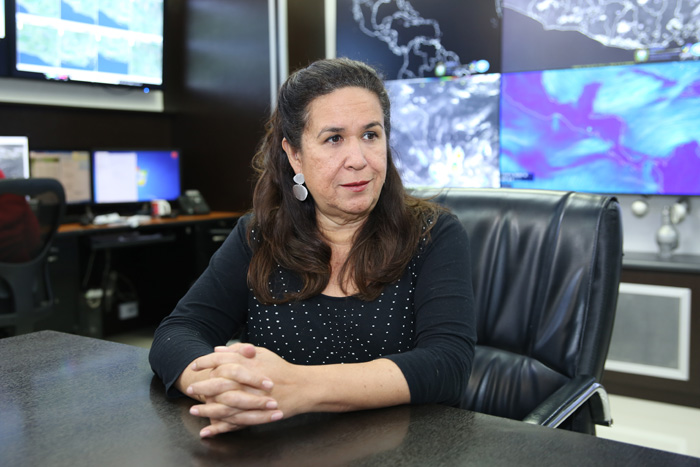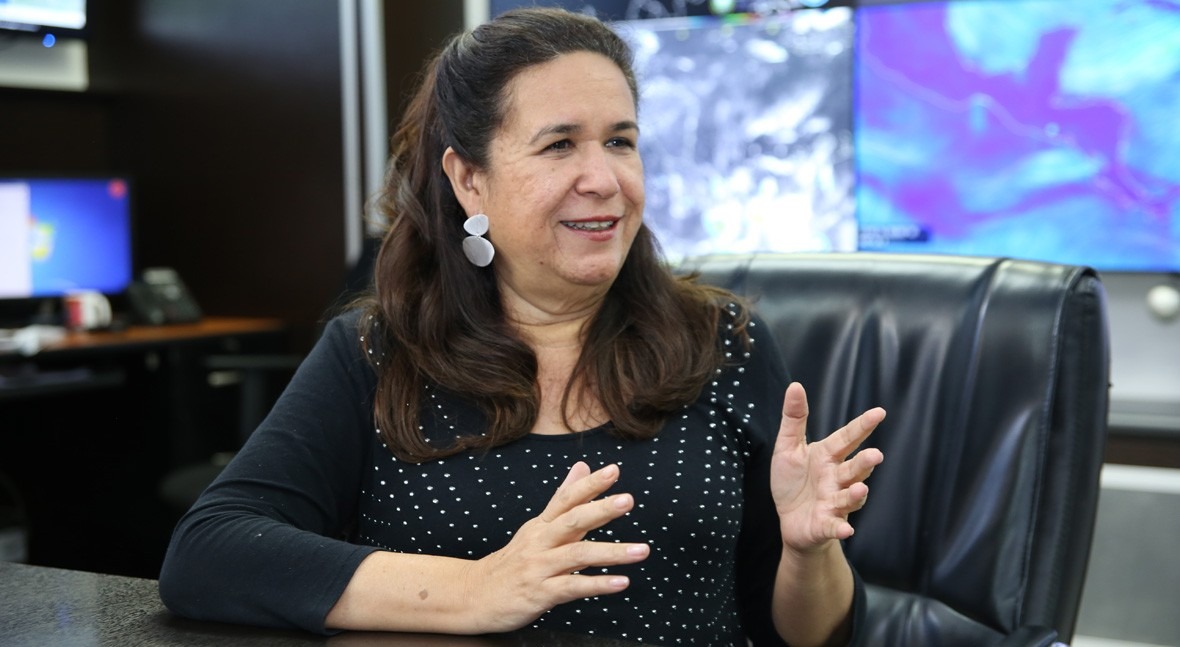At SWM we want to take a closer look at the water situation in the Latin American region as a whole, so we have carried out a series of interviews on #WaterinLATAM. Different public officials and experts in this field from Latin America have told us about the current situation and the future challenges that countries are facing with regards to water.
In this interview we talk with Lina Pohl, Minister of Environment and Natural Resources of El Salvador.
What do you think are the main water problems in Latin America?
I think that the biggest challenge nowadays with regards to water is climate change, so climate variability. Currently water resources are threatened. First, we have to consider the amount of water remaining in groundwater aquifers. All monitoring wells in El Salvador — and I think this is a common trend across Latin America — show that groundwater is being depleted.
Water resources are experiencing a serious impact, with two consequences: on one hand, significant dry periods that will affect agriculture, and on the other hand, sudden floods that will entail a risk of disasters and so on.
Secondly, I believe that the great problem Latin America is facing with regards to water is that we have not made progress — at least not in every country — concerning water resource planning. That is, how to allocate fairly this increasingly scarce resource, distribute it to all sectors, building infrastructure to convey water to those that do not have it.
And finally, there is the issue of drinking water: how to ensure water access in all communities, so the entire population has an adequate supply of drinking water. In Latin America there are still gaps in access to drinking water and sanitation in some communities, in every country.

How about in your country in particular?
Well, in El Salvador the issues are more or less as I described them. I think the primary issue is that we are depleting groundwater bodies. Secondly, a major problem linked to the previous one is that our natural water reserves (rivers, lakes, ponds) are polluted.
Although we have made great efforts to clean up the main water bodies, we still have poor water quality in our country.
What measures is the government taking in this regard?
We have three key actions to undertake. The first thing is to ensure that the entire population of El Salvador has access to drinking water and sanitation. According to the WASH Performance Index of the University of North Carolina, we are the top performing country with regards to our efforts to bridge the gap in access to drinking water and sanitation in our communities.
A second thing to do would be to ensure that the taps really have water, that is, that there is an adequate supply of water. Here the main task is to reclaim our rivers. The number of points with good water quality has increased. We regularly assess water quality at 155 points in the 55 main rivers in El Salvador, and the results indicate that from 2013 to 2017, when the last water quality report was issued, we made good progress. The monitoring results show there are no longer points with poor water quality, and the number of points with good water quality increased by 27%, but we still do not have excellent water quality in any of our rivers.
Thus, we have to clean up surface water bodies and ensure they provide an adequate supply of water, in order to stop using groundwater. A major problem in El Salvador is that groundwater is overexploited as an alternative to poor quality surface waters. For us, the issue of waste water sanitation is an ongoing problem, one of the key priorities.
And thirdly, we have to create water reservoirs, multipurpose dams, harvest rainwater, as essential measures to ensure the quality and quantity of water resources.
Over the past few years we have seen the concept of water governance gaining momentum. Is there awareness about the importance of water governance in your country? What are the main gaps?
Well, indeed, water issues imply how we manage and how we use water resources. I think that, without a doubt, we have made some progress in this area, creating water committees, committees to protect the most important river basins in the country, etc.; people recognise that water is essential, but a lot remains to be done.
We still think that we have more than enough water; there is no awareness of the need to use water efficiently, of water as a scarce resource that needs to be properly managed or administered. In my opinion the main hurdle to overcome is that one: understanding that water is a finite resource, that we could run out of it, and therefore it needs to be properly managed. I believe that is the big hurdle we have to overcome.

Is the existing legislation enough to manage water resources?
Not at all. There is an environmental law that proposes the protection of river basins and so on, but that is not enough to ensure effective river basin protection, because legislation is highly fragmented. For example, irrigation authorisations are issued by the Ministry of Agriculture and Livestock, industry authorisations are issued by the Ministry of Environment, and authorisations for tourism activities are issued by yet another authority. In other words, the institutional arrangements are highly fragmented and we do not have a National Water Authority to manage water resources in the best possible way.
It is not possible either to charge a fee or tax for water use and for discharges. Environmental legislation and other legislation do not include powers to charge for the use of this resource; some sectors of the population take advantage of this circumstance and misuse the resources.
In addition, civil society and other sectors are not really involved in preserving water resources or ensuring efficient and fair water use. That could be possible with a general water law, which unfortunately, has not been approved. A draft bill exists since 2012 and has been presented to the parliament; other draft bills have been added, but no decision has been made, and so there is no water law in the country.
What is the coverage of water supply and sanitation services in the country? What investments are required to increase coverage?
El Salvador has a National Integrated Water Resources Management Plan and a National Drinking Water and Sanitation Plan. According to the latter, in 2015 almost 90% — 89.9% — of the urban population in the country had drinking water services and 74.8% had sanitation services (flush toilet systems). In rural areas the coverage was lower: 70.6% of the population had drinking water supply systems and 69.5% had sanitation systems in place. We need further investments to ensure access to drinking water and sanitation, particularly in rural areas.
These services are part of the Sustainable Development Goals: we must achieve those goals in the country. A lot of effort has gone into bridging the gap in access to water and sanitation, but more investment is needed.
Agricultural water use plays a key role in the development of Latin America; what progress has been made in the country in the past few years? What are the objectives in this regard for the coming years?
Indeed, the agricultural sector is the biggest water user in El Salvador, and we have quantified the water demand by type of crop. Therefore, we know where those demands are located, and also the impact that agriculture has as a source of diffuse pollution, which is also quantified in the National Integrated Water Resources Management Plan. The main problems of agricultural demand units in the country have also been described.
We think that the work should focus on the following items (as per the National Integrated Water Resources Management Plan): increase system efficiency, encourage drip irrigation systems, build new water reservoirs for agricultural purposes, and establish monitoring processes in each of the demand units, to check that water resources are used efficiently for agricultural purposes.
Estimates indicate that the cost of low water quality in Latin America entails a loss of 1% to 3% of the GDP. Are there measurements of water quality in the country? What are the investments in this area?
Well, we have regular monitoring processes in place with sampling points designed to monitor the status of water bodies, mainly in surface water bodies. We are also making progress in monitoring groundwater bodies, and have increased four fold the number of water quality sampling points in groundwater bodies.
But we have not estimated the cost of poor water quality in terms of the GDP or the consequences it would have. In fact, one of the essential tasks we are now involved in is quantifying those costs, to even include them in our national accounts. Poor water quality does have a cost, not only because water treatment to make it potable becomes more expensive, but also because of the public health costs involved.
For example, in some regions of El Salvador there are high levels of some pollutants, including arsenic, copper and other heavy metals in water. This pollution has an impact on the incidence of certain diseases, such as chronic kidney disease due to non-traditional causes, and entails huge costs for our public health system.
I think that estimating the consequences of poor water quality in El Salvador is a pending task, and that is why addressing water quality issues is a priority in the agenda of the Ministry of Environment, and of the central government.

In general terms, does the user pay for all the costs of water conveyance and treatment? How are water prices set for the different uses?
That is the problem, there is no authority responsible for that, and not all the costs — not water conveyance and treatment — are charged to the end users. Water tariffs in El Salvador are established by the National Water Conveyance and Sewerage Authority (ANDA); that is the only price set for the use of potable water. It is established by this drinking water and sanitation public entity, and then it is submitted to the parliament and the Ministry of Economy for final approval. However, water tariffs do not include the costs of waste water treatment.
And the worst thing is that other uses, such as agriculture, livestock production or industrial activities do not have set tariffs. In El Salvador we only have set tariffs for drinking water.
What are the most important achievements in the country with regards to water security?
I think that drafting the National Integrated Water Resources Management Plan is a major achievement. The plan outlines the water resources available, in terms of quantity and quality, as well as the demand units and their status. That is, it describes water resources in detail and outlines actions to address water issues and ensure integrated, appropriate and effective water management.
We also have a National Water Resources Policy and Water Resources Regulations. Moreover, an excellent monitoring network measures not only water quantity but also water quality; a monitoring network reports flow and water levels in rivers and streams, etc.
And all that information feeds into a Water Resources Information System that compiles the data and facilitates decision making.
I think the most important point is the implementation of the plan. Although there have been some shortcomings in terms of implementing the policy, strategy and action plan, they are clearly defined and we have an information system to guide action.
Are public policies taking into account the effects of climate change?
Absolutely. We have a National Climate Change Plan with different climate change scenarios. The National Integrated Water Resources Management Plan defined scenarios under current conditions and under future climate scenarios, to forecast the effects of droughts and floods; it looked into what demand units would experience water stress as a result of climate change and under the different scenarios proposed.
This is essential for us, water is without a doubt the most important resource, and we are now working on a National Climate Change Adaptation Plan where water is a core theme..
What are the main water resource management challenges into the future?
I think that the main challenge, surely the most urgent one, is convincing the different actors of the need to have a general water law. We must approve a General Water Law, to have a National Water Authority that can make available to the public all the knowledge we already have about water resources.
A second major challenge is ensuring universal access to drinking water: it is part of the Sustainable Development Objectives that El Salvador has committed to.
Thirdly, concerning sanitation, we have to ensure that the impact on receiving water bodies is minimal. Our objective is to achieve excellent water quality, at least in those rivers which are key for human water supply. It is important to engage regional and local stakeholders in water management, involve public and private actors, and civil society, to ensure an integrated approach to resource management.
Water legislation should clearly establish the water allocations and reserves, that is, the maximum allocations per year and the water reserves that must be protected.




